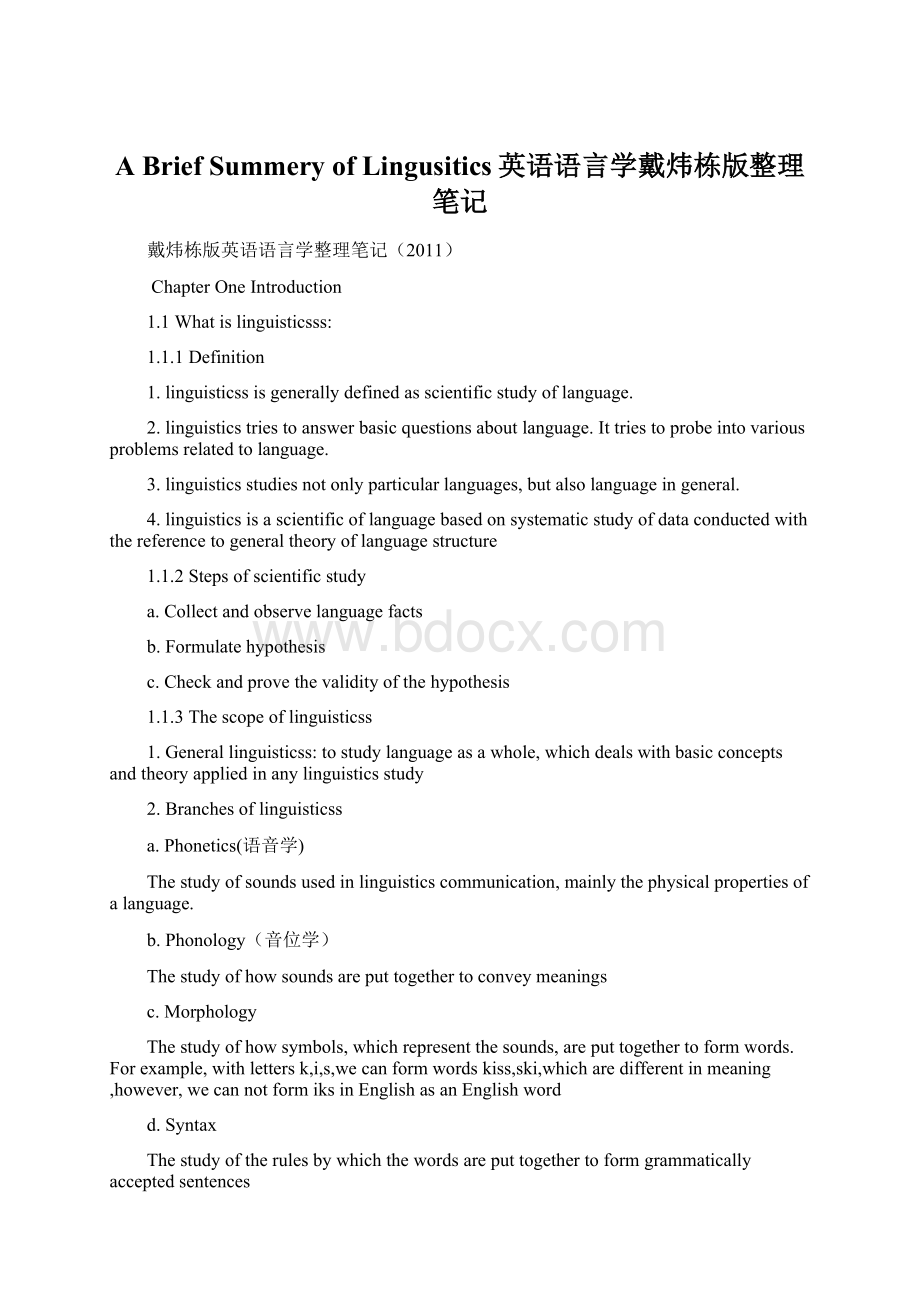A Brief Summery of Lingusitics英语语言学戴炜栋版整理笔记.docx
《A Brief Summery of Lingusitics英语语言学戴炜栋版整理笔记.docx》由会员分享,可在线阅读,更多相关《A Brief Summery of Lingusitics英语语言学戴炜栋版整理笔记.docx(45页珍藏版)》请在冰豆网上搜索。

ABriefSummeryofLingusitics英语语言学戴炜栋版整理笔记
戴炜栋版英语语言学整理笔记(2011)
ChapterOneIntroduction
1.1Whatislinguisticsss:
1.1.1Definition
1.linguisticssisgenerallydefinedasscientificstudyoflanguage.
2.linguisticstriestoanswerbasicquestionsaboutlanguage.Ittriestoprobeintovariousproblemsrelatedtolanguage.
3.linguisticsstudiesnotonlyparticularlanguages,butalsolanguageingeneral.
4.linguisticsisascientificoflanguagebasedonsystematicstudyofdataconductedwiththereferencetogeneraltheoryoflanguagestructure
1.1.2Stepsofscientificstudy
a.Collectandobservelanguagefacts
b.Formulatehypothesis
c.Checkandprovethevalidityofthehypothesis
1.1.3Thescopeoflinguisticss
1.Generallinguisticss:
tostudylanguageasawhole,whichdealswithbasicconceptsandtheoryappliedinanylinguisticsstudy
2.Branchesoflinguisticss
a.Phonetics(语音学)
Thestudyofsoundsusedinlinguisticscommunication,mainlythephysicalpropertiesofalanguage.
b.Phonology(音位学)
Thestudyofhowsoundsareputtogethertoconveymeanings
c.Morphology
Thestudyofhowsymbols,whichrepresentthesounds,areputtogethertoformwords.Forexample,withlettersk,i,s,wecanformwordskiss,ski,whicharedifferentinmeaning,however,wecannotformiksinEnglishasanEnglishword
d.Syntax
Thestudyoftherulesbywhichthewordsareputtogethertoformgrammaticallyacceptedsentences
e.Semantics
Thestudyofthemeaningconveyedbythesentencesorwords
f.Pragmatics
Thestudyofthemeaningofthewordsorsentencesinthecontextoflanguageuseratherthanthemeaninginisolation
g.Socialinguistics
Thestudyofsocialaspectsoflanguageortherelationshipbetweenlanguageandsociety
(a).Thelanguageapersonuserevealshissocialbackground.
(b).Thelanguagechangesarealwayscausedbythechangeofsociety.
h.Psycholinguistics
Itrelatedthestudyoflanguagetothestudyofpsychology.Ittriestoanswer
(a)Howthemindsworkwhenpeopleproducethelanguage
(b)Howinfantsacquiretheirmothertongue.
i.Appliedlinguistics
Thestudyoflanguageapplicationswhichsolvetheparticularproblems.Forexamplelanguageteachingandacquisition
1.1.4Someimportantdistinctions★:
A.Descriptionandprescription
(1)Descriptionandprescriptionaretwotypesoflanguagestudy.Descriptionistheanalysisofthelanguagethatpeopleactuallyuse.
(2)Prescriptionistolaydowntherulesforcorrectandstandardbehaviorinlanguageuse.Ittellspeoplewhatshouldsayandshouldnotsaywhenusingalanguage.
(3)ModernlinguisticsstudyisusuallydescriptivewhileoldEnglishisusuallyprescriptive
(4)Modernlinguisticsstudyisbelievedtobeobjectiveandscientificandthetaskformodernlinguisticsistodescribethelanguagepeopleuse.OldEnglish(TraditionalGrammar)istosetrulesforthecorrectusingoflanguage
B.Synchronicanddiachronic
(1)Synchronicstudyistostudylanguageatcertainpointoftimeinhistorywhilediachronicstudyistostudythehistoricaldevelopmentoflanguageoveraperiodoftime.Diachronicstudydescribelanguagesastheydevelop.
(2)Today,synchronicstudyismorepopularbecausewithoutsynchronicstudy,diachronicstudywillbeverydifficult.
C.SpeechandWriting
Modernlinguisticsregardspokenlanguageastheprimarymediumoflanguage,thereasonsareasfollows
(a).Accordingtolanguagerevolution,speechispriortowriting.Writingisusedforrecordingwhenitisnecessary,andtherearelanguagesthatdonothavewritingsystem
(b).Speechplaysamoreimportantroleintermsofthemessageitconveys.
(c).Whenacquiringmothertongue,spokenlanguageisfirstlyacquiredand
writingistaughtinschool
(d).Speechrevealstruefeaturesofalanguagebutwritingsystemisarecordformofspeech
D.Langueandparole
ThesetwoconceptswerecomeupwithbySaussure
1.Langueistheabstractlinguisticssystemsharedbyallthemembersofaspeechcommunity.Itisasetofrulesthatallthelanguageusershavetoabideby.
2.Paroleistherealizationoflangueinpracticaluse.Paroleisconcreteandvariousfrompersontoperson.Itreferstothenaturallyoccurredoflanguageevents
3.Sausurrebelievedthatparoleistooconfusingtobesystematicallystudiedandwhatlinguisticsstudyshoulddoistoabstractlanguefromparoleandlinguistsshouldstudylangueratherthanparole.
E.Competenceandperformance
a)ThesetwoconceptswerecomeupwithbyChomsky.Competenceistheidealusers’knowledgeoflanguagewhileperformanceistherealizationofthecompetence.
b)Chomskybelievesthatalthoughspeakershaveacquiretherulesforproducingcorrectsentences,theywillproduceungrammaticalsentencesduetopersonalorenvironmentalreasons.Therefore,competenceiswhatshouldbestudiedinlinguisticsstudy
c)索绪尔和乔姆斯基的理论比较:
BothSaussureandChomskybelievethattheabstractsystemsharedbylanguageusersshouldbestudiedwithouttheconsiderationofindividualityThedifferenceisSaussureviewtheabstractsystemfromthesocialaspect(Langue)andbelievethatlangueisasetofconventionsformemberstoobeywhileChomskyregardtheabstractsystemasapropertyofmindandcallitcompetencefrompsychologicalaspects.
F.Traditionalgrammarandmodernlinguistics
1.ThestartofmodernlinguisticsisthepublicationofSaussure’sCourseinGenerallinguistics
2.Differencesbetweentraditionalgrammarandmodernlinguistics
a.Traditionalgrammarisprescriptivebutmodernlinguisticsisdescriptive
b.Traditionalgrammaremphasizeswrittenlanguagewhilemodernlinguisticsregardsspokenlanguageastheprimaryofalanguage
c.ModernlinguisticsdoesnotjudgealanguagewiththestandardofanotherandEnglishisnotforcedtotheLatinforminmodernlinguistics.
1.2Whatislanguage★
1.2.1Definitionoflanguage
Languageisasystemofarbitraryandvocalsymbolsforhumancommunication
a.Arbitrary:
Thereisnoconnectionsbetweensoundsandthemeaningstheystandfor
b.Vocal:
Theprimarymediumforlanguageissymbols
c.Human:
Languageishumanspecific
1.2.2DesignFeature
a.Arbitrariness
Arbitrarinessmeansthatthereisnologicalconnectionsbetweenmeaningandsounds.Aexampleisthatdifferentlanguagesusedifferentwordsforthesameobjects.Arbitrarinessmakesitpossibleforlanguagestohaveunlimitedsourcesofexpressions
b.Productivity
Productivitymeansthatlanguageuserscanconstructandinterpretgrammaticallyacceptedsentencesthathaveneverbeenusedbeforequickly.Productivityishumanspecific
c.Duality
Dualitymeansthatlanguagehastwolevelssoundlevelandmeaninglevel.Soundlevelisalowerlevelwithoutmeaning.However,atthehigherlevel,thesoundsaregroupedintosmallunitesofmeaningandthenintosentences.Anexampleissoundslike/k/、/p/、/a:
/aremeaninglessbuttheycanbearrangedinto/pa:
k/(park)or/ka:
p/(carp)whicharemeaningful.Dualityallowspeopletotalkaboutanythingwithintheirknowledge
d.Displacement
Displacementallowspeopletotalkaboutthingswhichareremovedfromtheimmediatesituationofthespeakers.Thispropertyallowsspeakerstotalkaboutthingsfreefromseparationoftimeandspace
e.Culturaltransmition
Humancapacityforlanguagehasageneticbasis,i.e.wearebornwiththeabilityforacquiringlanguage.However,thedetailofalanguageisculturallytransmittedbylanguageteachingandlearning
ChapterTwoPhonology
2.1Thephonicmediumoflanguage
(1).Speechandsoundaretwomediausedbynaturallanguageforcommunication
(2).Twothirdsoflanguagesdonothavewrittenformstoday
(3).Linguistsareinterestedinthesoundsproducedbyspeechorgansandplayanimportantroleinlinguisticscommunication.
(4).Themeaningfulsoundsinhumancommunicationconstitutethephonicmediaoflanguage.Themeaningfulindividualsoundiscalledspeechsound.
2.2Phonetics
2.2.1whatisphonetics
A.Phoneticsisthestudyofphonicmediaoflanguage
B.Phoneticsstudiessoundsfromthreerelatedbutdistinctaspects.
a.Articulationphonetics(发声语音学):
tostudythesoundfromspeakers’pointofview(howweproducesounds)
b.Auditoryphonetics(听觉语音学):
tostudysoundfromthehears’pointofview(howwehearsounds)
c.Acousticphonetics(语音传播学):
tostudyhowsoundistransmittedbylookingatsoundwaves
d.Articulatoryphoneticshasthelongesthistoryamongthreebranches.Acousticphoneticsstudiesphysicalpropertiesofsoundswithspectrographs(频谱仪)
2.2.2Organsofspeech:
Thearticulatoryapparatuscontainspharyngealcavity(咽腔),oralcavity(口腔)andnasalcavity(鼻腔)
1.Pharyngealcavity
①Glottis(声门)isthefirstplacewheresoundmodificationmayoccur.
②Vocalcordslieacrossglottis,theycanbeheldtightlytocutoffstreams
③Whenthevocalcordsarepartiallyopen,thevibrationofvocalcordsmayresultinvoicedsoundsincludingvowelsandsomeconsonants
④Whenthevocalcordsaredownwidetoletairgothrough,thesoundswillbevoiceless(由此可见,声带是否震动决定了这个音是带声还是不带声,而无法区别音是元音还是辅音)
2.Oralcavity
①Thegreatestsourceformodificationofairstreamisfoundinoralcavity
②Oralcavityincludestongue,uvular(小舌),softplate(软腭),hardplate(硬腭)teethridge(齿龈),teeth,lips.Tongueisthemostflexibleamongtheall.
3.Nasalcavity:
①Nasalcavityandoralcavityareconnectedwitheachother
②Thesoftpalatecandownbacktoclosethepassagesothattheaircanonlycomefrommouth,whichwillproduceunassimilatedsounds(无鼻音化音)includingvowelsandmostconsonants.Ifthepassageisopentolettheairgofromthenose,thesoundsproducedarecallednasalconsonantsincluding[m]、[n]、[ŋ]
2.2.3